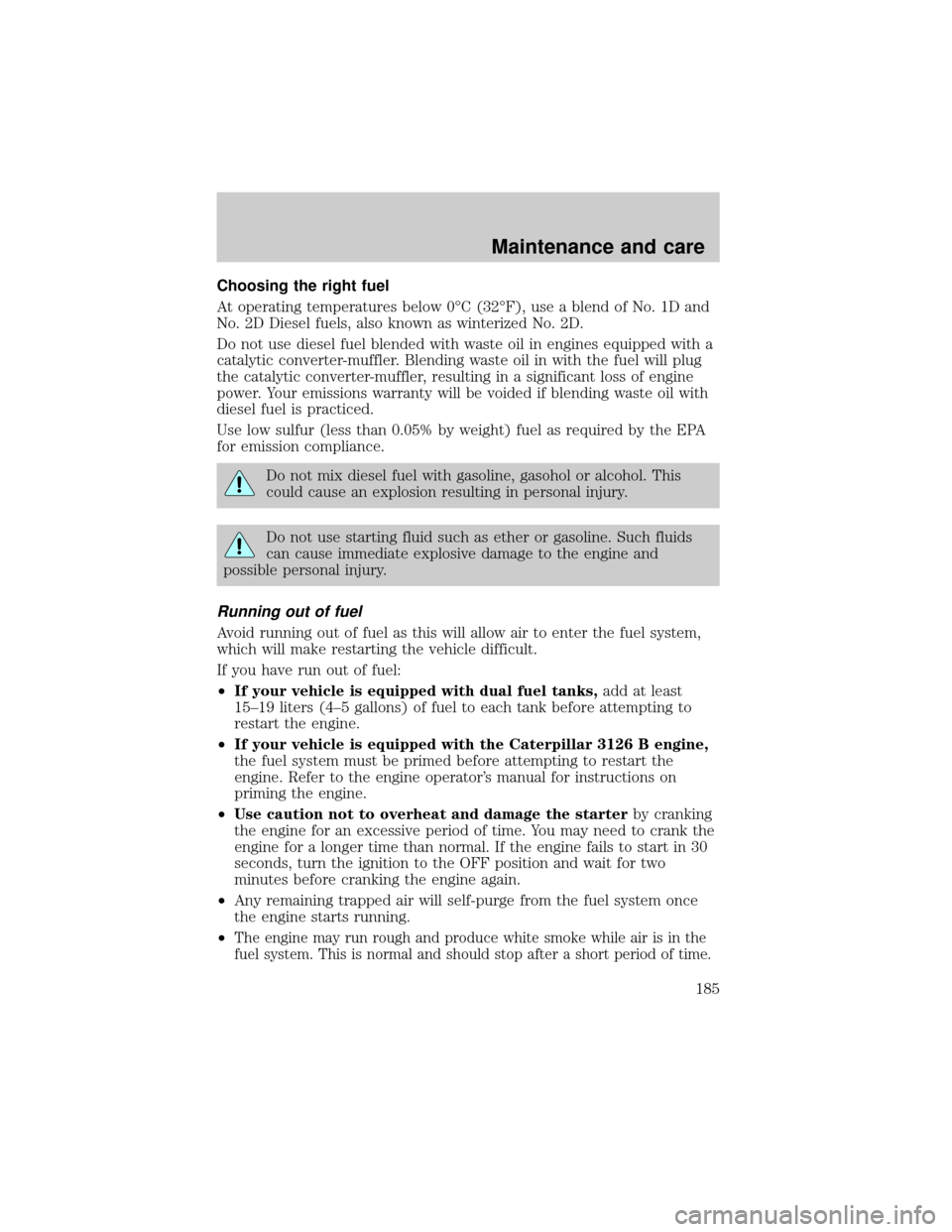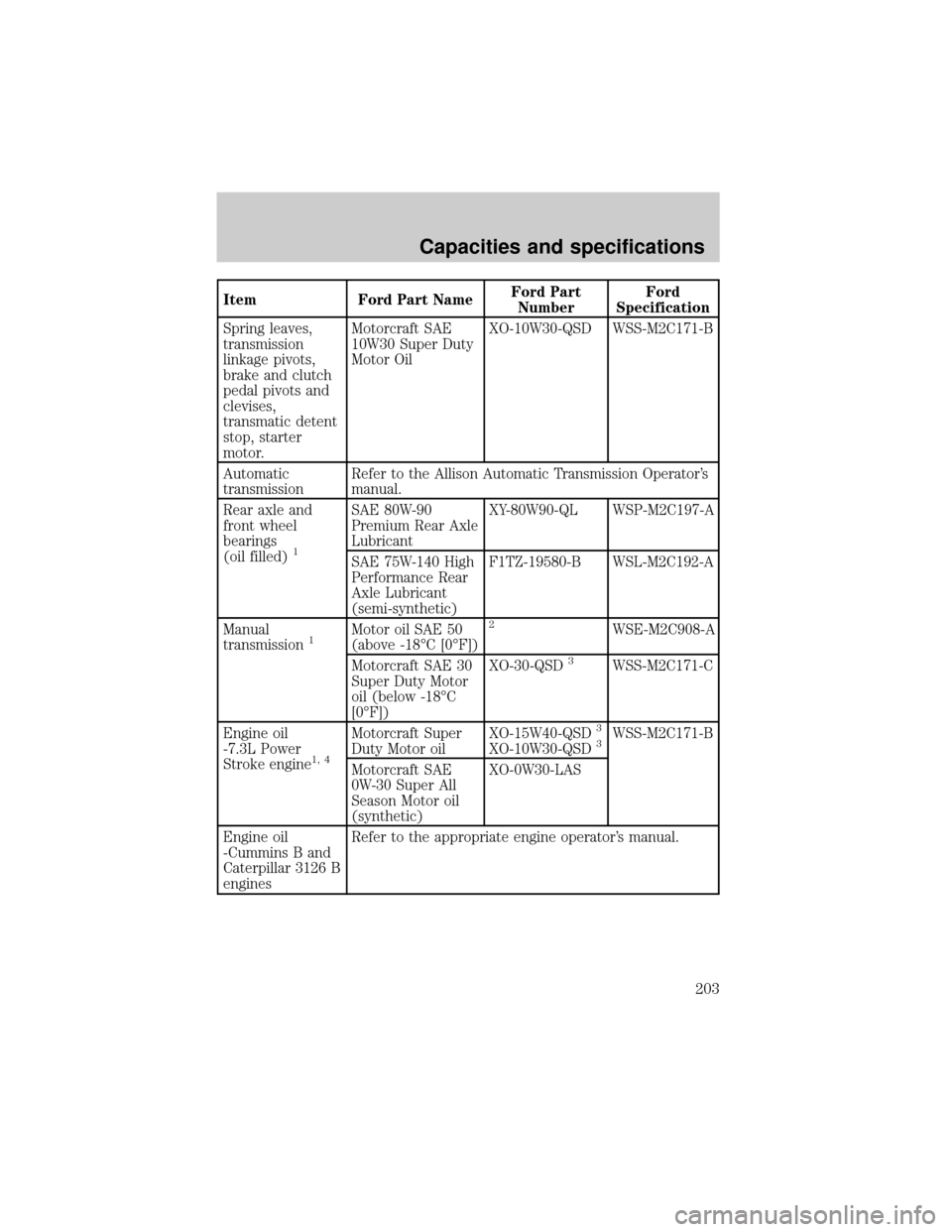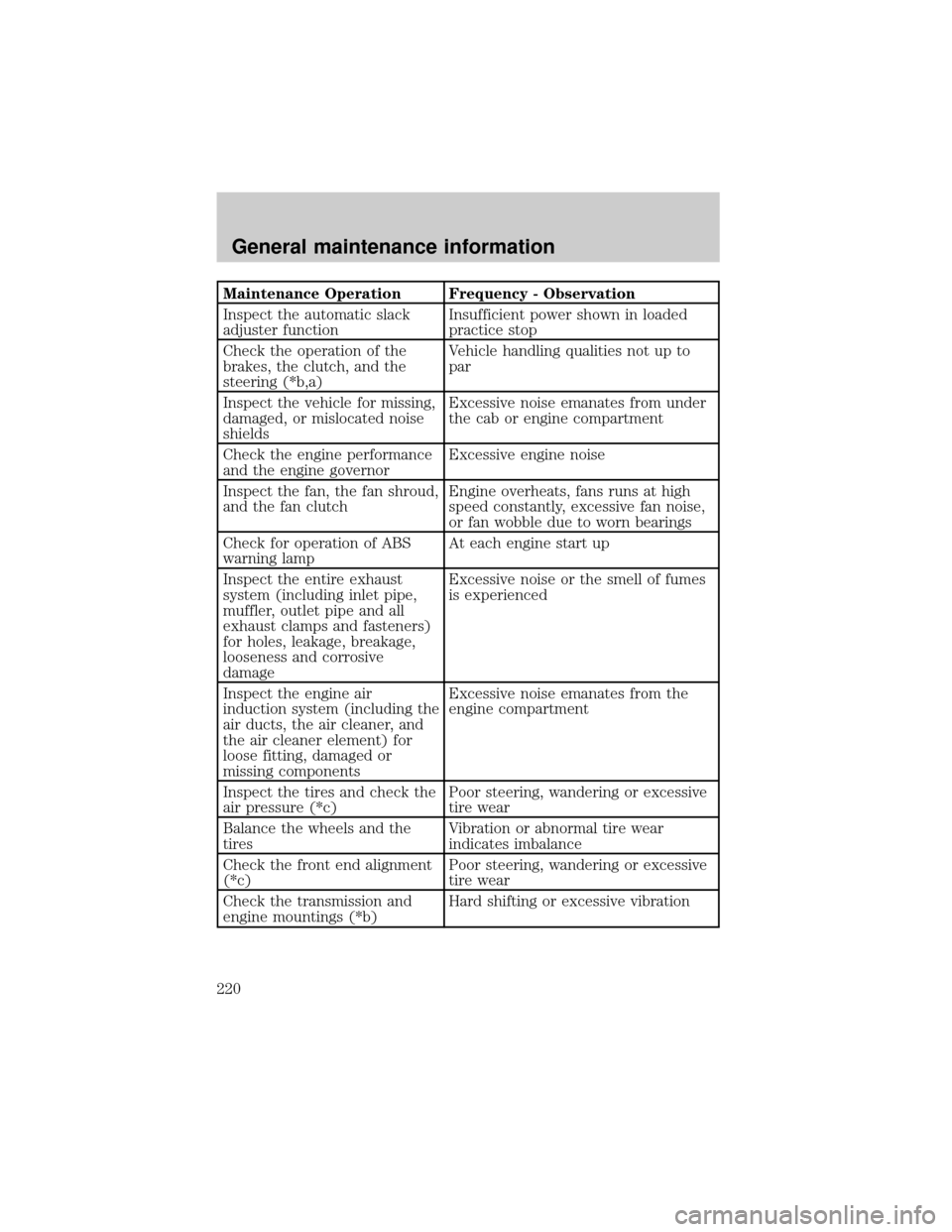Page 150 of 240
Fuse/Relay
LocationFuse Amp
RatingPower Distribution Box
Description
104 20A** Power Point
105 20A** Power Door Locks
106 30A** Headlamps
107 50A** Junction Box Battery Feed (fuses
1, 2, 3, 4, 12, 13, 14, 15)
108 40A** Cummins Fuel Heater
109 40A** Power Windows
110 30A** Power Seats (SuperCrewzer only)
111 30A** Body Builder Prep
112 40A** Blower Motor
113 30A** Heated Seats (SuperCrewzer
only)
114 30A** E-Brake (SuperCrewzer only)
115 40A** Ignition Switch (JB fuses 5, 8, 9,
11, 21)
116 30A** Body Builder Prep
117 20A** 7.3L Power Stroke PCM
118 30A** IDM (7.3L Power Stroke only)
119
12060A** Hydraulic ABS, Air Brake Trailer
Tow Fuse Block
121
12260A** Hydromax Motor, Air Brake
Trailer Tow Fuse Block
201 Ð Washer Pump Relay
202 Ð Wiper Speed Relay
203 Ð Wiper Run/Park Relay
204 Ð 7.3L Power Stroke Neutral Start
Relay, Stoplamp Relay (CAT and
Cummins only)
205 Ð Right Hand Stop/Turn Relay
206 Ð Left Hand Stop/Turn Relay
Roadside emergencies
150
Page 185 of 240

Choosing the right fuel
At operating temperatures below 0ÉC (32ÉF), use a blend of No. 1D and
No. 2D Diesel fuels, also known as winterized No. 2D.
Do not use diesel fuel blended with waste oil in engines equipped with a
catalytic converter-muffler. Blending waste oil in with the fuel will plug
the catalytic converter-muffler, resulting in a significant loss of engine
power. Your emissions warranty will be voided if blending waste oil with
diesel fuel is practiced.
Use low sulfur (less than 0.05% by weight) fuel as required by the EPA
for emission compliance.
Do not mix diesel fuel with gasoline, gasohol or alcohol. This
could cause an explosion resulting in personal injury.
Do not use starting fluid such as ether or gasoline. Such fluids
can cause immediate explosive damage to the engine and
possible personal injury.
Running out of fuel
Avoid running out of fuel as this will allow air to enter the fuel system,
which will make restarting the vehicle difficult.
If you have run out of fuel:
²If your vehicle is equipped with dual fuel tanks,add at least
15±19 liters (4±5 gallons) of fuel to each tank before attempting to
restart the engine.
²If your vehicle is equipped with the Caterpillar 3126 B engine,
the fuel system must be primed before attempting to restart the
engine. Refer to the engine operator's manual for instructions on
priming the engine.
²Use caution not to overheat and damage the starterby cranking
the engine for an excessive period of time. You may need to crank the
engine for a longer time than normal. If the engine fails to start in 30
seconds, turn the ignition to the OFF position and wait for two
minutes before cranking the engine again.
²Any remaining trapped air will self-purge from the fuel system once
the engine starts running.
²
The engine may run rough and produce white smoke while air is in the
fuel system. This is normal and should stop after a short period of time.
Maintenance and care
185
Page 195 of 240

Using the right bulbs
Function Number of
bulbsTrade number
Headlamps 2 4652
Park/turn signal 2 1157
Sidemarker/rear marker lamp 5 red 12
(amber)194
Tail/stop lamp 4 2057
Backup 4 1156
Foglamp 2 899
Running board/courtesy lamp 6 194
License plate lamp 2 194
Cabmarker 5 168
Exterior visor lamp (if equipped) 4 194
Rear fender clearance 4
(a)
Rear identification 3 194
Dome lamp 1 105
To replace all instrument panel lights - see your dealer
(a)Replace entire lamp assembly; bulb is not serviceable.
AIMING THE HEADLAMPS
The headlamps on your vehicle are properly aimed at the assembly plant.
If your vehicle has been in an accident the alignment of your headlamps
should be checked by a qualified service technician.
MINOR TROUBLESHOOTING GUIDE
Diesel engine
For troubleshooting information, refer to the diesel engine operator's
manual.
If engine won't crank
For troubleshooting information, refer to the engine operator's manual.
If engine cranks but won't start
For troubleshooting information, refer to the engine operator's manual.
Maintenance and care
195
Page 203 of 240

Item Ford Part NameFord Part
NumberFord
Specification
Spring leaves,
transmission
linkage pivots,
brake and clutch
pedal pivots and
clevises,
transmatic detent
stop, starter
motor.Motorcraft SAE
10W30 Super Duty
Motor OilXO-10W30-QSD WSS-M2C171-B
Automatic
transmissionRefer to the Allison Automatic Transmission Operator's
manual.
Rear axle and
front wheel
bearings
(oil filled)
1
SAE 80W-90
Premium Rear Axle
LubricantXY-80W90-QL WSP-M2C197-A
SAE 75W-140 High
Performance Rear
Axle Lubricant
(semi-synthetic)F1TZ-19580-B WSL-M2C192-A
Manual
transmission
1Motor oil SAE 50
(above -18ÉC [0ÉF])2WSE-M2C908-A
Motorcraft SAE 30
Super Duty Motor
oil (below -18ÉC
[0ÉF])XO-30-QSD
3WSS-M2C171-C
Engine oil
-7.3L Power
Stroke engine
1, 4
Motorcraft Super
Duty Motor oilXO-15W40-QSD3
XO-10W30-QSD3WSS-M2C171-B
Motorcraft SAE
0W-30 Super All
Season Motor oil
(synthetic)XO-0W30-LAS
Engine oil
-Cummins B and
Caterpillar 3126 B
enginesRefer to the appropriate engine operator's manual.
Capacities and specifications
203
Page 220 of 240

Maintenance Operation Frequency - Observation
Inspect the automatic slack
adjuster functionInsufficient power shown in loaded
practice stop
Check the operation of the
brakes, the clutch, and the
steering (*b,a)Vehicle handling qualities not up to
par
Inspect the vehicle for missing,
damaged, or mislocated noise
shieldsExcessive noise emanates from under
the cab or engine compartment
Check the engine performance
and the engine governorExcessive engine noise
Inspect the fan, the fan shroud,
and the fan clutchEngine overheats, fans runs at high
speed constantly, excessive fan noise,
or fan wobble due to worn bearings
Check for operation of ABS
warning lampAt each engine start up
Inspect the entire exhaust
system (including inlet pipe,
muffler, outlet pipe and all
exhaust clamps and fasteners)
for holes, leakage, breakage,
looseness and corrosive
damageExcessive noise or the smell of fumes
is experienced
Inspect the engine air
induction system (including the
air ducts, the air cleaner, and
the air cleaner element) for
loose fitting, damaged or
missing componentsExcessive noise emanates from the
engine compartment
Inspect the tires and check the
air pressure (*c)Poor steering, wandering or excessive
tire wear
Balance the wheels and the
tiresVibration or abnormal tire wear
indicates imbalance
Check the front end alignment
(*c)Poor steering, wandering or excessive
tire wear
Check the transmission and
engine mountings (*b)Hard shifting or excessive vibration
General maintenance information
220
Page:
< prev 1-8 9-16 17-24